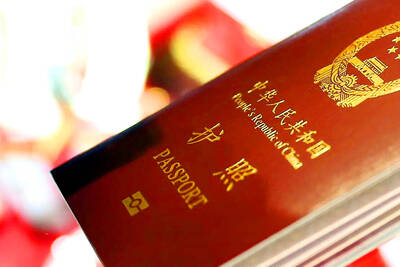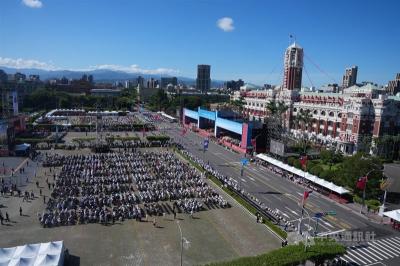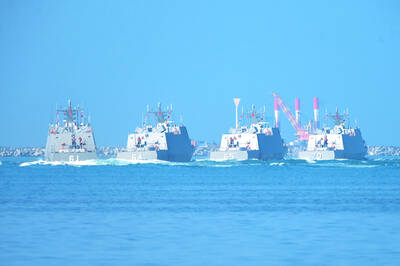Major upgrades to Taiwan’s F-16 fighter jets are under threat from US government budget cuts, according to recent reports.
If plans to replace the avionics and radars in the 146 F-16A/B jets do not go ahead, it could deal a huge blow to the nation’s defenses.
According to reports published in Defense News and on the Internet, the US Air Force (USAF) is cutting the Combat Avionics Programmed Extension Suite (CAPES) from the Pentagon’s budget for next year, which is scheduled to be released on March 4.
US Department of Defense officials reached by the Taipei Times refused to confirm or deny the reports.
While Taiwan may still be able to go ahead on its own and fund the upgrades — currently priced at about US$5.3 billion — the costs would be much greater and perhaps prohibitive without US participation.
With Taiwan already making drastic military cuts, its economy struggling and with billions of dollars in US arms purchases outstanding, Taipei may not be able to afford it.
US President Barack Obama promised the upgrades in 2011 after he turned down Taipei’s repeated requests to buy more advanced F-16C/D jets.
There was a great deal of publicity about the upgrades at the time, with Washington experts touting them as a way for Taipei to maintain a credible defense to deter or at least slow down a possible Chinese invasion of the nation until US forces could reach the scene.
Without the upgrades, the nation’s aging air force fleet will have very limited stopping power.
Defense News called the development “potentially devastating” for Taiwan and quoted one expert as saying it has created a “crisis.”
The publication also quoted Ed Ross, president of the Virginia-based EWRoss International consulting firm, as saying: “With no new F-16C/Ds approved for Taiwan, its Air Force is up a creek with not much of a paddle and I’m not sure there is anyone in the Obama administration that gives much of a damn.”
The US Air Force had originally planned to upgrade 300 F-16s under the CAPES program and the economy of scale would have thus reduced the costs for upgrading Taiwan’s fighters.
Under the upgrade program, Taiwan’s F-16s were to receive Northrop Grumman scalable agile beam radar, which would give them an enormous advantage in combat.
Taiwan could now try to join South Korea or Singapore in less attractive upgrade programs or plead again with Obama to sell F-16C/Ds.
However, pressure from Beijing is almost certain to stop a sale of the more advanced jets.
Defense News said that “multiple sources” had told them the CAPES program was being dropped to make funds available for an F-16 service life extension program.
This is terrible news for the balance of power in the East China Sea,” a defense industry site said. “With this decision, China no longer has to worry about hundreds of F-16s with advanced radar, mission computers and EW [electronic warfare] sensors in the potential East China Sea conflict, as none of the USAF and ROCAF [Republic of China Air Force] F-16s would pose a threat to China’s advanced fighter types operating in the area.”
“For the first time, China would gain an upper hand over the US-Japan-Taiwan in the East China Sea,” the Web site added.
Losing the F-16 upgrade could be “grave” for Taiwan, said Rick Fisher, a senior fellow at the International Assessment and Strategy Center in Alexandria, Virginia.
However, he told the Taipei Times that it was still possible that the program could survive or that it may just be delayed.
“It would be a travesty — especially during the 35th anniversary of the Taiwan Relations Act — to allow Taiwan’s fighter upgrade program to become a casualty of American budget politics,” he said.
Fisher said that if the Pentagon dropped the program, it would undermine Washington’s credibility in Taipei, as well as erode other US alliances in Asia.
“After several years of testing, China has recently started producing the Chengdu J-10B for Chinese Air Force units,” he said.
The J-10B likely has an active electronically scanned array (AESA) radar, which is the same kind of technology that was meant to be added to Taiwan’s F-16A fighters, Fisher said.
AESA radar systems are also likely to be used by Shenyang’s new J-16 twin-seat strike fighter and by future versions of the Shenyang J-15 aircraft carrier fighter, he said, adding that an AESA radar-equipped fighter would have a decisive advantage.
If the F-16 upgrade program fails, the US should encourage and help Taiwan to establish new missile programs, Fisher said.

The Ministry of the Interior (MOI) is to tighten rules for candidates running for public office, requiring them to declare that they do not hold a Chinese household registration or passport, and that they possess no other foreign citizenship. The requirement was set out in a draft amendment to the Enforcement Rules of the Public Officials Election and Recall Act (公職人員選舉罷免法 ) released by the ministry on Thursday. Under the proposal, candidates would need to make the declaration when submitting their registration forms, which would be published in the official election bulletin. The move follows the removal of several elected officials who were

The Republic of China (ROC) is celebrating its 114th Double Ten National Day today, featuring military parades and a variety of performances and speeches in front of the Presidential Office in Taipei. The Taiwan Taiko Association opened the celebrations with a 100-drummer performance, including young percussionists. As per tradition, an air force Mirage 2000 fighter jet flew over the Presidential Office as a part of the performance. The Honor Guards of the ROC and its marching band also heralded in a military parade. Students from Taichung's Shin Min High School then followed with a colorful performance using floral imagery to represent Taiwan's alternate name

FOUR DESIGNATED AREAS: Notices were issued for live-fire exercises in waters south and northwest of Penghu, northeast of Keelung and west of Kaohsiung, they said The military is planning three major annual exercises across the army, navy and air force this month, with the navy’s “Hai Chiang” (海強, “Sea Strong”) drills running from today through Thursday, the Ministry of National Defense said yesterday. The Hai Chiang exercise, which is to take place in waters surrounding Taiwan, would feature P-3C Orion maritime patrol aircraft and S-70C anti-submarine helicopters, the ministry said, adding that the drills aim to bolster the nation’s offshore defensive capabilities. China has intensified military and psychological pressure against Taiwan, repeatedly sending warplanes and vessels into areas near the nation’s air defense identification zone and across

A Chinese takeover of Taiwan would severely threaten the national security of the US, Japan, the Philippines and other nations, while global economic losses could reach US$10 trillion, National Security Council Deputy Secretary-General Lin Fei-fan (林飛帆) wrote in an article published yesterday in Foreign Affairs. “The future of Taiwan is not merely a regional concern; it is a test of whether the international order can withstand the pressure of authoritarian expansionism,” Lin wrote in the article titled “Taiwan’s Plan for Peace Through Strength — How Investments in Resilience Can Deter Beijing.” Chinese President Xi Jinping’s (習近平) intent to take Taiwan by force